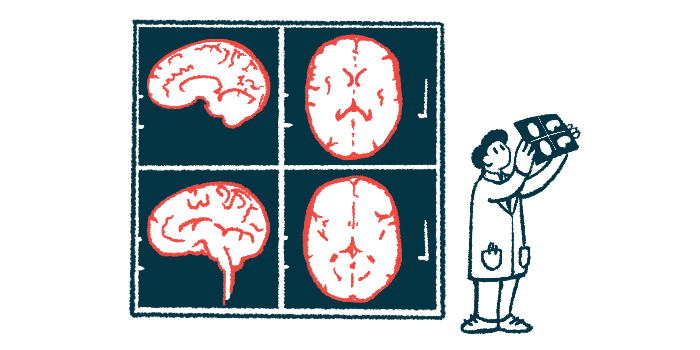Brainstem lesions linked to acute respiratory failure: Study
Swallowing difficulties, paralysis also may be predicting factors

The presence of lesions in the brain’s middle medulla, a control center for breathing, increases the likelihood of acute respiratory failure in people with neuromyelitis optica spectrum disorder (NMOSD), a study suggests.
While middle medullary lesions on MRI were the key predictor of acute respiratory failure in patients with medullary involvement, the data suggested that swallowing difficulties and paralysis of all limbs may also be predicting factors.
“Early diagnosis and therapy may improve NMOSD prognosis, and predicting ARF [acute respiratory failure] is significant for NMOSD treatment strategies,” researchers wrote.
The study, “Predictors for acute respiratory failure in AQP4-IgG-positive neuromyelitis optica spectrum disorders patients with medullary lesions,” was published in the Journal of Clinical Neuroscience.
NMOSD occurs when the immune system mistakenly attacks the optic nerves, the spinal cord, and sometimes the brainstem, a stalk-like structure that sits at the base of the brain.
Given that the cervical spinal cord and medulla oblongata, the bottom part of the brainstem, “are the sites of the respiratory centre, NMOSD cases experiencing life-threatening acute respiratory failure (ARF) have been reported,” the researchers wrote.
Complication associated with increased mortality in those with NMOSD
Acute respiratory failure occurs when breathing is no longer adequate to respond to the body’s needs, causing the blood to have not enough oxygen. This complication is associated with increased mortality in people with NMOSD.
However, “the relationship between brainstem lesions and ARF in NMOSD has previously been neglected,” the researchers wrote.
To address this, a team of researchers in China retrospectively analyzed the demographic, brain MRI, and clinical data from 128 NMOSD patients with brainstem involvement who were seen at a single hospital in South China.
Patients’ mean age was 39 years, and most (88.3%) were women. All tested positive for antibodies against AQP4, the most common type of self-reactive antibodies that drive NMOSD.
On brain MRI scans, all had new or recurrent medullary lesions. Many had symptoms related to this type of lesions, most commonly area postrema syndrome (53.1%), a condition marked by uncontrollable nausea, vomiting, or hiccups that can sometimes be the first sign of NMOSD.
About 20% of patients also experienced a form of paralysis that affects all four limbs, or quadriplegia (21.1%), and swallowing difficulties or dysphagia (19.5%).
A total of 17 patients (13.3%) had acute respiratory failure, called the ARF group. These patients were significantly more likely to be men and to have more severe disease — as assessed with the Expanded Disability Status scale and the modified Rankin Scale — than those without such respiratory complication.
A significantly greater proportion of patients with acute respiratory failure had dysphagia (94.1% vs. 8.11%) and quadriplegia (47.1% vs. 17.1%) relative to those without the complication. At admission, pneumonia also was significantly more common in the ARF group (58.8% vs. 0%). Pneumonia is an inflammation of the lungs usually caused by an infection.
To the researchers’ surprise, area postrema syndrome was not significantly associated with acute respiratory failure, occurring in comparable proportion of patients with versus without the respiratory complication (47.1% vs. 54.1%).
“The reason for this phenomenon might be that in patients with intractable hiccups and nausea, their lesions are mainly located in dorsal portions of the medulla oblongata, presumably involving the putative vomiting centre in the area postrema instead of the primary respiratory centre,” the team wrote.
Lesions in the middle portion of the medulla, which is home to the olivary nuclei (MON) that plays an important role in breathing control, were detected in 21 patients (16.4%).
These MON lesions were more than 16 times as common in those who had experienced acute respiratory failure as in those who had not (88.2% vs. 5.4%), “illustrating the close relationship” between the two, the researchers wrote.
In turn, there were no significant differences in the rate of different types of spinal cord lesions.
Analyses showed MON lesions were significantly associated with acute respiratory failure
Statistical analyses adjusted for potential influencing factors showed that MON lesions were significantly associated with a nearly threefold higher chance of having acute respiratory failure.
The presence of MON lesions had a positive predictive value of 71.4%, and a negative predictive value of 98.1% for acute respiratory failure. This meant that 71.4% of patients with MON lesions had acute respiratory failure, while 98.1% of those without such lesions had no acute respiratory failure.
In eight of the patients, MON lesions were detected before acute respiratory failure occurred. They accounted for more than half (53.3%) of patients with both MON lesions and acute respiratory failure in the study.
These findings suggest that “the involvement of the MON on MRI is the main cause and a predictor for ARF” in APQ4-related NMOSD patients with medullary lesions, the researchers wrote.
Some clinical features that are related to MON lesions, such as dysphagia and quadriplegia, “may also be predictors for ARF, making it possible for clinical neurologists to predict ARF quickly even before conducting MRI scans,” the team wrote.
Further studies are needed to confirm these findings, they noted.







